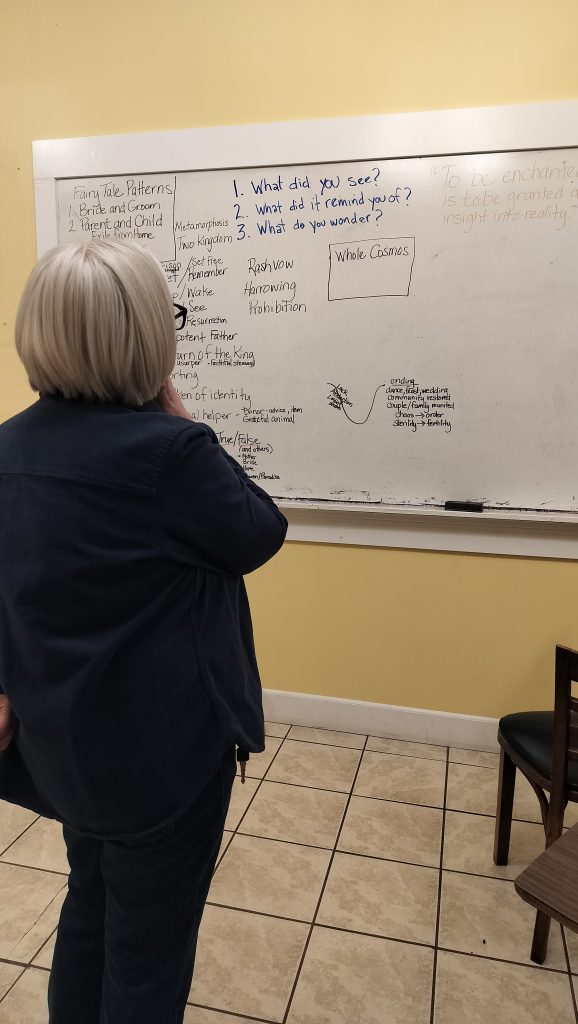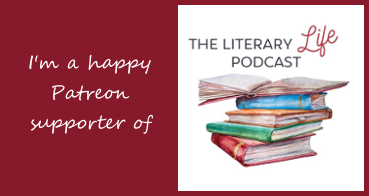I’ve had the wonderful experience these past 10 weeks of reading story to four-year-olds, taking things a little deeper with my 6-9 year old group, with telling back what we saw and what it reminded us of, and then with the age-10-and-up group, teaching story patterns and images. (You can read about my classes here.)
For that oldest group, I prepare each week by relistening to segments of the How to Read Fairy Tales class that I took with House of Humane Letters in the summer of 2021. I add to my notes in my notebook and in my copies of the fairy-tales that I am reading with this oldest group. I do some editing of words and illustrations that I’ve put on the whiteboard. Each time that I listen to my teacher going through the story on the recordings, I find myself going to the board and considering the big picture and finding that universal story becoming clearer and clearer to me.
Frankly, I am becoming enchanted by story like never before. And that deeper insight into reality is very much connected to that universal story.
A couple of weeks ago, our story was The Frog King, or Faithful Heinrich. It is a story of a not-so-nice princess who, right at the beginning of the story, is playing with a favorite ball that rolls into a well. The ball is recovered by a frog.
Blah-blah-blah you might think as a modern reader. But as it turns out, that image of a little girl playing with a gold ball was huge in the medieval world. They understood that ball to represent the whole cosmos. (Let me say right here that we have lost so much by losing the knowledge of these images, and not seeing the world metaphorically the way that our ancestors of too many generation ago did.) So when a hearer of that folk tale centuries ago told or heard that story, they totally saw that scene as a fallen cosmos that was brought back up by this frog. Of course, that’s not the end of that story, nor is it the end of our story if you make the connection to something that happened to our fallen world about 1,993 years ago.
Jakob and Wilhelm Grimm were collectors of stories. Like, really intense collectors. When publishing their collection, they put The Frog King (Der Froschkönig oder der eiserne Heinrich) first. I spent a lot of time contemplating this last weekend as I prepared for my class, and then shared these thoughts with my class on Tuesday. It seems to me that by purposely placing this story first, the brothers Grimm were introducing us to what all story is about. Every mythology that I know tells of a fallen world. Often we are told of a previous golden age of whatever length, and then something happens to precipitate that loss of innocence and safety. Think Adam and Eve in the Garden. Think Pandora and that box. Literary critic Northrop Frye believed that every story is about an exile from home, a paradisal place of innocence and safety, and a longing to return to that home.
Number 50 in that Grimms’ collection is Little Brier-Rose, or what we know as The Sleeping Beauty. Interestingly, it is a frog that comes to tell Brier-Rose’s mother that she will have a child, and it is said many listeners of this tale would associate that frog with the frog of the first story. But there is another connection that I’d like to address at this time. You are probably familiar with the tale of a curse being put on the baby by a disgruntled fairy (Disney version) or wise-woman (traditional and Grimms version), and that curse being put into effect on her 15th birthday when she pricked her finger on that spindle. Not only does Brier-Rose sleep for 100 years (the softening addendum on the curse by the 12th wise woman), but the entire castle, including all the bugs, sleep as well. The whole castle is under the curse. During that 100 years thorns grow around the castle, keeping every one else out, and causing the death of many princes who come to wake the princess. There are a few things that these thorns could be an image of, which I won’t give away here. (Hey, take my class, or HHL’s fairy tale class!) But the other day as I stared at my white board where I had written the word whole cosmos, and I considered those images of the golden ball and that castle completely surrounded by thorns, I was overwhelmed at the similarity of those two images. That castle, enclosed in those thorns, represented an entire fallen cosmos. They all slept. To fall. To rise. To sleep. To wake. To die. To be resurrected. Death to Life. The true Prince didn’t just make it through those thorns ….well, actually this is what happened: When the prince approached the thorn hedge, it was nothing but large, beautiful flowers that separated by themselves, allowing him to pass through without harm, but then behind him closed back into a hedge. Pretty cool, right? He was the True Prince, and he came at just the right time. So, anyhow, he didn’t just wake one person; he brought the entire castle (cosmos, my friends) back to life. Don’t tell me you don’t know what I’m talking about. That’s right.
So here’s the deal: You must enter story and take story at its own terms. Enter. Look around. It’s quite enchanting. What do you see? What does it remind you of? What do you wonder?

To be enchanted by story is to be granted a deeper insight into reality.
~Stratford Caldecott






